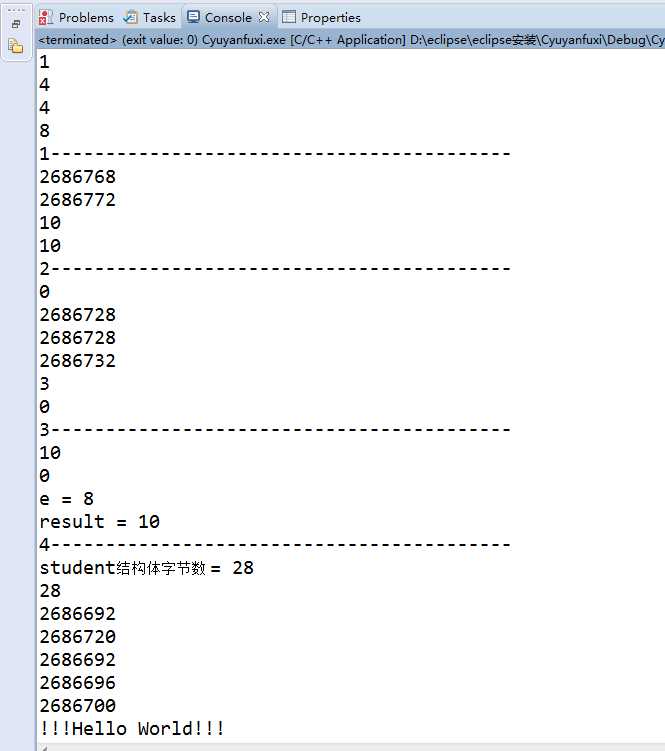标签:指针 调用 script 定义 stm32 函数 独立 变量 根据
1 /* 2 ============================================================================ 3 Name : Cyuyanfuxi.c 4 Author : 5 Version : 6 Copyright : Your copyright notice 7 Description : Hello World in C, Ansi-style 8 ============================================================================ 9 */ 10 11 #include <stdio.h> 12 #include <stdlib.h> 13 //函数声明 14 void reset(int i); 15 void reset2(int* p); 16 void add_by_point(int x,int y,int *result); 17 //结构体定义 18 struct student 19 { 20 int age; 21 float weight; 22 char name[20]; 23 }; 24 void struct_caculate(struct student *p); 25 26 int main(void) 27 { 28 //求类型的字节 29 printf("%d\n",sizeof(char));//1字节 30 printf("%d\n",sizeof(int));//4字节 31 printf("%d\n",sizeof(float));//4字节 32 printf("%d\n",sizeof(double));//8个字节输出p1,也就是a的地址 33 puts("1------------------------------------------"); 34 int a = 10;//定义一个整型变量a,并赋值为10 35 int *p1 = &a;//定义一个指针*P1,赋值为变量a的地址, 36 char *p2 = p1;//定义一个字符变量p2,赋值为p1的地址 37 printf("%d\n",p1);//输出p1,也就是a的地址(2686776) 38 //运算要根据类型 39 printf("%d\n",p1+1);//输出4210696,也就是2686776+4,因为p1是int类型4字节,所以加4 40 printf("%d\n",*p1);//带*号的意思是输出p1里面的内容,10 41 printf("%d\n",*p2);//10 42 puts("2------------------------------------------"); 43 int code[10] = {1 ,2,3,4,5};//定义一个数组 44 //结论:数组内容值默认为0 45 printf("%d\n",code[5]);//输出数组的第5个值,但是数组只有第4个,数组有定义10个,那么数组内容默认为0 46 //结论:数组名也是数字首地址 47 printf("%d\n",code);//求数组名的地址 2686732 发现一样的 48 printf("%d\n",&code[0]);//求数组的第一个数字的地址 2686732 49 //指针运算要根据指针的类型 50 printf("%d\n",code+1);//求数组加一的地址,输出2686732+4 51 52 printf("%d\n",*(code+2));//求数组第三个数字的值,3 53 *(code+2) = 0;//(code+2)是一个地址,*(code+2)是内容,现在把0赋值为里面的内容 54 printf("%d\n",*(code+2));//0 55 puts("3------------------------------------------"); 56 int d = 10; 57 reset(d);//函数的调用 58 //结论:函数的独立性, 59 printf("%d\n",d);//10 60 reset2(&d);//取地址 61 //使用指针的方式突破函数壁垒 62 printf("%d\n",d);//0 63 //什么是返回值 64 int e = add(3,5); 65 printf("e = %d\n",e);//8 66 int result = 0;//?? 67 //指针的方式计算结果 68 add_by_point(5,5,&result); 69 printf("result = %d\n",result);//10 70 puts("4------------------------------------------"); 71 printf("student结构体字节数 = %d\n",sizeof(struct student));//4+4+20=28 72 struct student kinson = //结构体赋值 73 { 74 21,61,"kinson" 75 }; 76 printf("%d\n",sizeof(kinson));//28 77 printf("%d\n",&kinson);//取结构体名kinson的地址2686692 78 //结构体指针运算根据指针的类型来判断 79 printf("%d\n",(&kinson+1));//2686692+28=2686720 80 //结构体的地址就是第一个成员的地址 81 printf("%d\n",&kinson.age);//2686692 82 //结构体成员的地址是连续的 83 printf("%d\n",&kinson.weight);//2686696 84 printf("%d\n",&kinson.name);//2686700 85 86 //printf("%d\n",kinson.name); 87 puts("!!!Hello World!!!"); /* prints !!!Hello World!!! */ 88 89 return EXIT_SUCCESS; 90 } 91 void reset(int i)//定义一个子函数 92 { 93 i = 0;//赋值i=0; 94 } 95 void reset2(int* p)//定义一个指针函数 96 { 97 *p = 0;//指针p的内容是0 98 } 99 100 int add(int i,int j )//定义一个子函数,什么是返回值要用 101 { 102 /* 103 变量的生命周期 104 */ 105 106 int q = i+j; 107 return q; 108 } 109 void add_by_point(int x,int y,int *result)//指针函数要用 110 { 111 int r = (x + y); 112 *result = r; 113 } 114 115 void struct_caculate(struct student *p) 116 { 117 118 p->name = "kinson2"; 119 120 121 }

标签:指针 调用 script 定义 stm32 函数 独立 变量 根据
原文地址:http://www.cnblogs.com/kinson/p/7536431.html